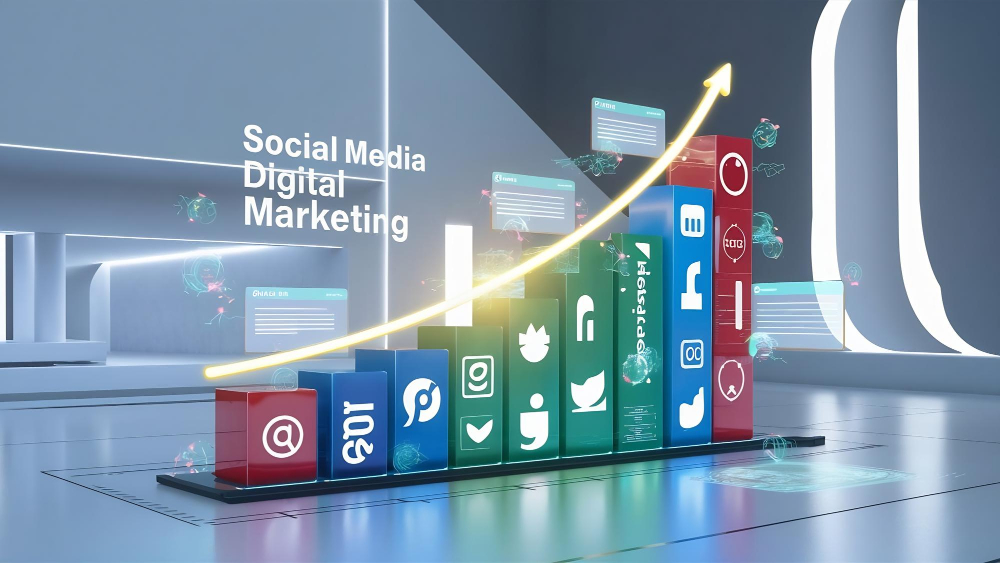- info@uxgenmarketing.com
- U-211, Vaishnav Enclave, Sec 67A. Gurugram. Haryana. 122101
Digital Marketing – The Growth Engine Behind Modern Business

Digital Marketing – The Growth Engine Behind Modern Business
A quick story to start
A founder I met last month in Gurgaon sighed and said, “Manoj, I’m doing everything—Instagram reels, Google Ads, a blog once in a while—still, results feel…random.”
I smiled, because I’ve been there. Busy. Hopeful. Exhausted. And then it clicks: results aren’t random; systems create results. Digital marketing, when done right, is the engine that turns attention into revenue—quietly, every single day.
This article is your guide to that engine—how it works, what to measure, and how UXGen Studio (design + UX + conversion) and UXGen Marketing (SEO + ads + content + automation) help you build it with fewer guesses and more growth.
Why digital marketing matters (and the data to prove it)
Let’s anchor this in reality, not hype.
- Digital now dominates ad spend. In 2025, global ad spend is expected to surpass $1 trillion, with over 75% of it being digital. That’s where your customers are—scrolling, searching, and deciding.
- Email still prints money (when respected). New research reveals that most companies achieve an email ROI of between 10:1 and 36:1. If you treat email as a relationship channel—not a spam cannon—it quietly compounds growth.
- Personalization isn’t a nice-to-have anymore. When done well, it can increase revenue by 5–15% and boost marketing ROI by 10–30%, while also reducing acquisition costs. That’s not magic, it’s data and orchestration.
- Friction is expensive. The global average cart abandonment rate hovers around 70%. If your checkout, forms, or landing pages are clunky, you pay for traffic twice—first to bring people in, then in lost sales.
- People often make decisions in a “messy middle.” Real buyer journeys fluctuate between exploration and evaluation across numerous touchpoints. Your brand wins when you consistently and helpfully show up in that messy middle.
The simple version: what “engine” are we building?
Think of your growth engine as four connected loops:
- Demand – People discover you (search, social, PR, partner referrals).
- Consideration – They learn and trust (content, reviews, demos, webinars).
- Conversion – They act (landing pages, offers, checkout, sales calls).
- Retention & Expansion – They return and refer (via email, community, support, and upsell).
Most teams do everything everywhere. Winners sequence the work and optimize each loop—week after week.
What good looks like in 2025

1) Findability: be there when intent shows up
- SEO for problems, not just products. People search for pain first, brand later. Map 50–100 real searches your buyer makes across the journey; write honest answers with examples from your work.
- Short-form video + helpful carousels. Current data shows that the short form continues to deliver a strong ROI when it’s valuable and authentic—not overly produced. Pair videos with a “Save/DM for template” CTA.
2) Trust: remove doubt, add proof
- Use before/after snapshots, 3-slide mini case studies, and simple benchmarks (“typical onboarding in 7 days”) backed by your real process.
- Add pricing clarity and transparent FAQs on landing pages. Hidden costs are conversion killers.
3) Conversion: make doing business feel easy
- Ruthlessly simplify forms (fewer fields), page load (optimize images), and navigation (one primary CTA).
- Run A/B tests on headlines, forms, offers, and checkouts—every month. Small lifts compound. (Yes, testing is directly tied to better email and conversion performance in industry research.)
4) Retention: respect the inbox, earn the repeat
- Treat email like an ongoing service, not a weekly pitch. Send field notes, teardown videos, and client stories.
- Personalize by behavior (what they read or watched), not just by name. The ROI case for personalization is real—and now table stakes.
A 90-day plan you can follow
Days 1–15: Baseline & message
- Clarify one core promise and two priority personas.
- Audit analytics, search console, and ad accounts; fix obvious tracking gaps.
Days 16–30: Fix the leaky bucket
- Rebuild your homepage hero, one flagship landing page, and one lead magnet.
- Improve form UX (field reduction, progress indicators), add social proof, and compress images for improved performance.
Days 31–60: Consistent demand
- Publish one pillar article and four supporting posts tied to real questions.
- Launch two ad sets: (1) intent (search) and (2) education (short-form video + remarketing).
- Start a 2-email welcome series (value + proof), then weekly insights.
Days 61–90: Scale what works
- Double down on top-performers; pause the rest.
- Introduce cart/lead abandon automations.
- Begin quarterly experiments (pricing page copy test, offer structure, demo lite, or calculator tool).
How UXGen Studio helps (design that converts)

We’re a UX-first team. Translation: we make it easy to say yes.
- Conversion-first landing pages. Clear promise, proof, and path—designed for speed, accessibility, and mobile realities.
- Checkout & form UX. We reduce steps, clarify feedback, and eliminate micro-frictions that contribute to the alarming 70% abandonment rate.
- Content design systems. Repeatable layouts for case studies, product pages, and tutorials so your team ships faster—and on brand.
- Measurement baked in. Every design ships with tracking plans and A/B test ideas, not just pixels.
“Design isn’t decoration. It’s a business lever. When pages read like your buyer’s inner voice, conversions feel natural—not forced.”
How UXGen Marketing helps (growth operations you can trust)
We’re your hands-on marketing ops partner—focused on outcomes, not vanity metrics.
- SEO that respects users. We map real questions (the “messy middle” moments) and create content that answers, compares, and clarifies—no fluff.
- Paid media with discipline. We start small, test fast, and scale only the winners. We use creative sprints for hooks and ad angles.
- Lifecycle email & CRM. Welcome series, win-back flows, lead nurture—personalized by behavior to compound ROI over time.
- Analytics & governance. We connect ad platforms, CRM, and product analytics so your “what happened” turns into “what to do next.”
- Personalization at scale. From channel mix to on-site experiences, we implement the data and tooling that power the 5–15% revenue lifts McKinsey consistently finds.g
A realistic “mini-case” (composite, anonymized)
A mid-size B2B service brand came to us with rising ad costs and flat revenue. In 10 weeks:
- We rewrote the homepage promise and rebuilt the top funnel page with a single, sharp CTA.
- We launched a pillar guide and three comparison pages that answer real buyer doubts.
- We set up two email sequences: a 2-step “welcome & value” and a 3-step “case-led nurture.”
- We reduced media waste and reallocated the budget toward intent-based keywords and remarketing.
- We instrumented tracking: source → content → form → deal.
Results? Fewer leads, better leads. Sales calls felt warmer. Win rates climbed. Revenue followed. No miracle—just less friction, more clarity, and compounding trust.
(Note: shared as a composite example to protect client privacy; outcomes vary with execution and market conditions.)
What to measure (so you don’t get lost)
- Time to first value: How quickly a new visitor gets something genuinely worthwhile.
- Lead quality/win rate: Marketing’s job isn’t about generating more leads; it’s about generating more qualified leads.
- Cost to Acquire (CTA) & Payback: Are you earning back ad and content investments within your target window?
- Revenue influenced by email: Lifecycle programs quietly do heavy lifting. Track them.
- Personalization impact: Start with straightforward recommendations, such as content and segmented offers—and monitor the lift.
Common mistakes I see (so you can avoid them)
- Everything, everywhere, all at once. Pick a lane for 90 days.
- Design without data. Beautiful pages that don’t convert are expensive, yet ineffective posters.
- Burying proof. Make evidence—logos, quotes, before/after—impossible to miss.
- Ignoring speed and mobile. Slow pages make expensive traffic useless.
- Treating email like a megaphone. It’s a conversation. Respect the inbox and you’ll love the ROI.
If you want help right now.
- UXGen Studio can audit your site, rebuild one high-stakes journey (home → offer → form), and set up your following three A/B tests.
- UXGen Marketing can install a clean growth stack (analytics, search console, CRM), initiate a clarity-first content plan, and execute smart, targeted paid campaigns while your organic engine gains momentum.
We’ll meet you where you are, move fast, and teach your team as we go—so the engine keeps running long after the kickoff buzz fades.
FAQs

Q1. How much should a small business invest in digital marketing?
Start with a clear goal and work backwards. Many SMBs begin at 5–10% of revenue across content, ads, and tooling, then adjust based on payback. Invest first where intent is highest (search, website UX), then build your content and email engine.
Q2. How long until I see results?
Paid search and UX fixes can make a significant impact in just weeks. SEO, authority, and email marketing typically compound and show a meaningful lift in 3–6 months. Treat this as building an asset, not spinning a slot machine.
Q3. Is email still worth it in 2025?
Absolutely—if you respect your reader and tailor your behavior accordingly. Industry data shows strong ROI ranges for well-run programs.
Q4. What’s one change that can boost conversions quickly?
Clarity beats clever. Tighten your headline promise, reduce form fields, surface proof, and fix mobile performance. You’re likely losing more to friction than you think (remember that ~70% cart abandonment benchmark).
Q5. Should I chase every new channel (influencers, short-form video, etc.)?
Test with intention. Short-form works when it’s genuinely helpful and on-brand, but don’t starve the basics: search, site UX, and email.
Sources & further reading
- Insider Intelligence / eMarketer — Worldwide Ad Spending Forecast 2025 (digital >75% of total). EMARKETERcloud.insight.insiderintelligence.com
- Litmus — The ROI of Email Marketing (2025). Litmus
- McKinsey — What is personalization? (impact on revenue, acquisition costs, ROI). McKinsey & Company
- Baymard Institute — Cart & Checkout UX Research / Abandonment Benchmark (~70%). Baymard Institute
- Think with Google — The Messy Middle (non-linear journeys). Google Business
- Salesforce — State of Marketing (9th ed.) (multichannel personalization practices). Salesforce+1
- HubSpot — State of Marketing 2025 (short-form & video ROI themes). HubSpot+1
Final word
If your growth feels random, it’s not because your product isn’t good. It’s because your engine isn’t tuned yet. Tighten the promise. Remove friction. Show proof. Respect the inbox. Measure what matters.
And if you’d like a partner who blends design craft with marketing discipline, UXGen Studio and UXGen Marketing are ready to build that engine with you—step by step, test by test—until growth stops feeling like luck and starts feeling like process.







